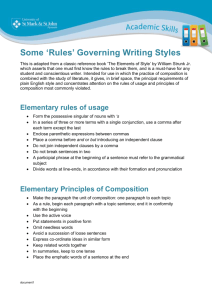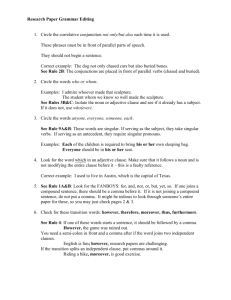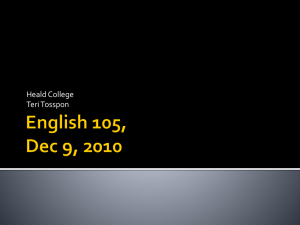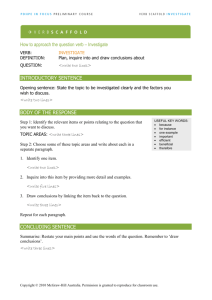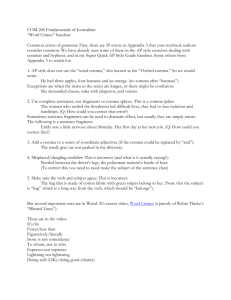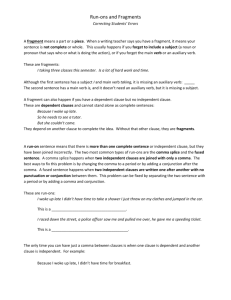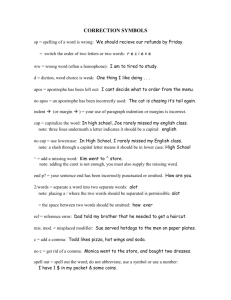Word - Bakersfield College
advertisement
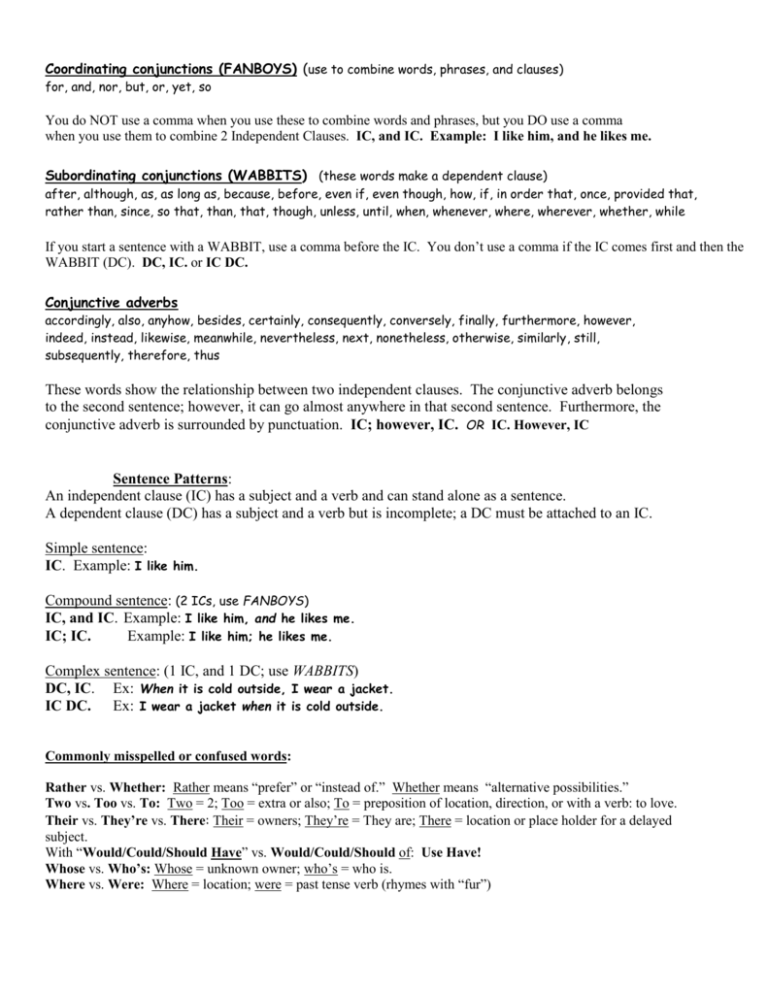
Coordinating conjunctions (FANBOYS) (use to combine words, phrases, and clauses) for, and, nor, but, or, yet, so You do NOT use a comma when you use these to combine words and phrases, but you DO use a comma when you use them to combine 2 Independent Clauses. IC, and IC. Example: I like him, and he likes me. Subordinating conjunctions (WABBITS) (these words make a dependent clause) after, although, as, as long as, because, before, even if, even though, how, if, in order that, once, provided that, rather than, since, so that, than, that, though, unless, until, when, whenever, where, wherever, whether, while If you start a sentence with a WABBIT, use a comma before the IC. You don’t use a comma if the IC comes first and then the WABBIT (DC). DC, IC. or IC DC. Conjunctive adverbs accordingly, also, anyhow, besides, certainly, consequently, conversely, finally, furthermore, however, indeed, instead, likewise, meanwhile, nevertheless, next, nonetheless, otherwise, similarly, still, subsequently, therefore, thus These words show the relationship between two independent clauses. The conjunctive adverb belongs to the second sentence; however, it can go almost anywhere in that second sentence. Furthermore, the conjunctive adverb is surrounded by punctuation. IC; however, IC. OR IC. However, IC Sentence Patterns: An independent clause (IC) has a subject and a verb and can stand alone as a sentence. A dependent clause (DC) has a subject and a verb but is incomplete; a DC must be attached to an IC. Simple sentence: IC. Example: I like him. Compound sentence: (2 ICs, use FANBOYS) IC, and IC. Example: I like him, and he likes me. IC; IC. Example: I like him; he likes me. Complex sentence: (1 IC, and 1 DC; use WABBITS) DC, IC. Ex: When it is cold outside, I wear a jacket. IC DC. Ex: I wear a jacket when it is cold outside. Commonly misspelled or confused words: Rather vs. Whether: Rather means “prefer” or “instead of.” Whether means “alternative possibilities.” Two vs. Too vs. To: Two = 2; Too = extra or also; To = preposition of location, direction, or with a verb: to love. Their vs. They’re vs. There: Their = owners; They’re = They are; There = location or place holder for a delayed subject. With “Would/Could/Should Have” vs. Would/Could/Should of: Use Have! Whose vs. Who’s: Whose = unknown owner; who’s = who is. Where vs. Were: Where = location; were = past tense verb (rhymes with “fur”) IC = Independent Clause: Subject + Verb + Complete Idea/Thought—EX: Today is Monday. DC = Dependent Clause: Subject + Verb + Incomplete Idea/Thought—EX: If today is Monday. (clauses are made dependent by attaching one of the WABBITS in front of an IC) Fragment = Sentence is missing a subject or a verb, or it is just a DC without an IC. Comma Rules: 1. Use a comma when you combine 2 ICs together. (a FANBOY follows the comma) 2. Use a comma to separate each item in a series. 3. Use a comma after introductory elements (DCs, Prepositional Phrases, Transitions, etc.) 4. Use two commas to surround interrupters (transitions, conjunctive adverbs). 5. Use a comma with dates, addresses, and 5-digit numbers.. Pronoun Antecedent Agreement Antecedent = NOUN Pronoun = substitute for a noun RULE: Pronouns that sub for a noun must match the noun in number (singular form vs. plural form). 1. For singular nouns that could be male or female (student, person, athlete, customer), use “he or she,” “his or her,” or “him or her.” Example: If a student wants to do well, he or she will study. (Or use plurals: Students/they) 2. The following indefinite pronouns are considered singular: Anybody, anyone, everybody, everyone, each, every, either, nobody, none, neither, somebody, and someone. Use “he or she,” “his or her,” or “him or her.” Example: If somebody wants to do well, he or she will study. (Ur use specific plural nouns: teens/they) 3. Collective nouns (team, committee, family) seem plural, but they are singular. Use it or its. Example: The committee is presenting its report at the board meeting tonight. NOTE: when you can, use plural nouns so you can avoid using it or its, “he or she,” “his or her,” or “him or her.” Example: The members of the committee are presenting their report tonight. Example: If students want to do well, they will study. How to Organize Your Essay Introductory Paragraph: The first paragraph includes your way of bringing up the subject/topic—maybe with a small story or some general comments on the topic. It ends with your answer to the topic question; that answer is called the thesis. The introduction is usually no less than 3 sentences BUT can be more than 3. Body Paragraphs: Each body paragraph should have one and only one idea that supports the thesis. The main idea of support should be your first sentence and the rest of the sentences in the paragraph should offer evidence for and examples of that idea. A well developed paragraph will have 5 or more sentences. Your FEE should have at least one body paragraph, but it is likely to have 2 or more. Concluding Paragraph: This paragraph signals the end of your paper. You might re-say your thesis, but change the wording. You might go over your main ideas of support, but don’t copy them exactly. This is likely to be your shortest paragraph.
